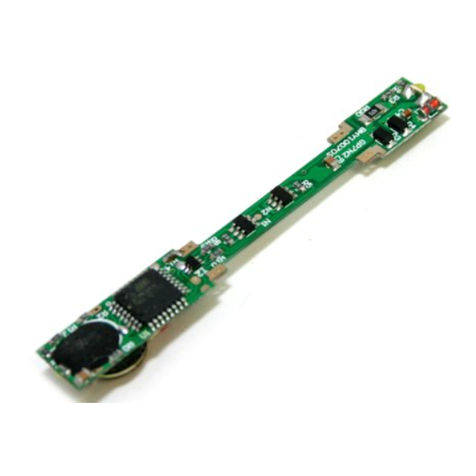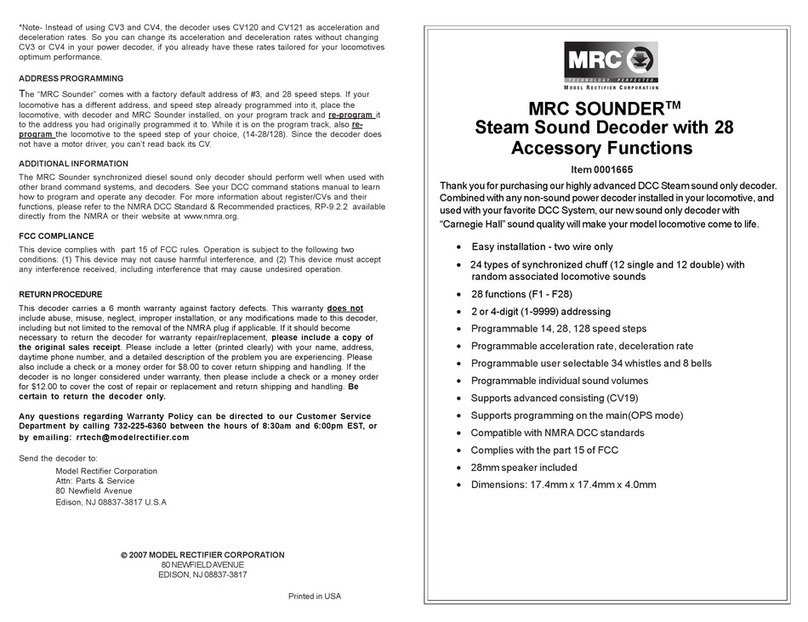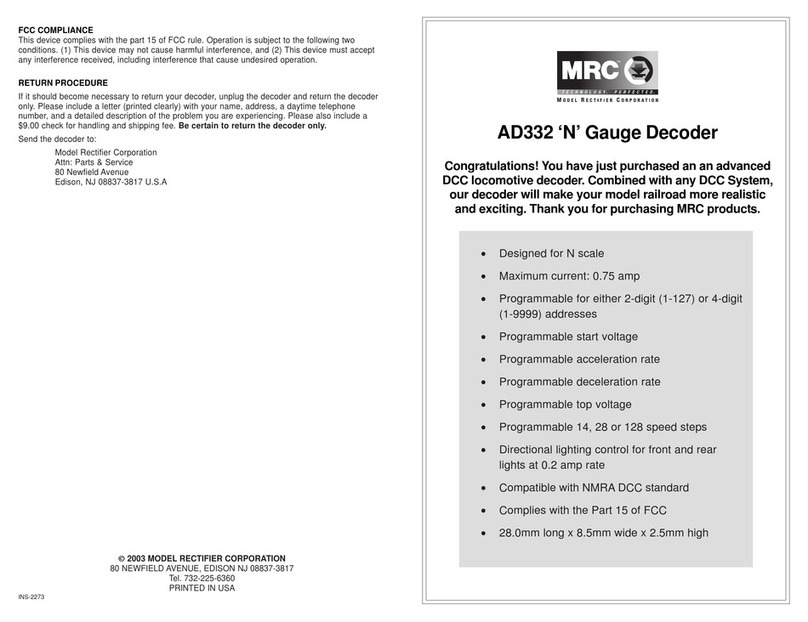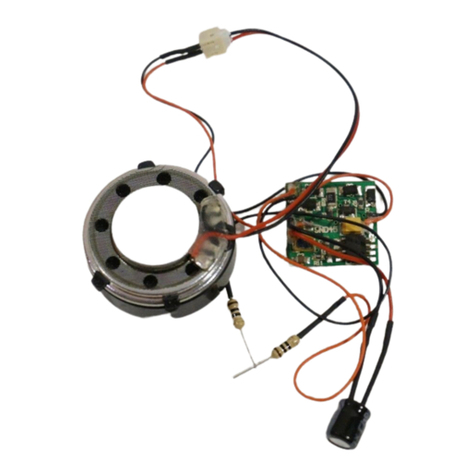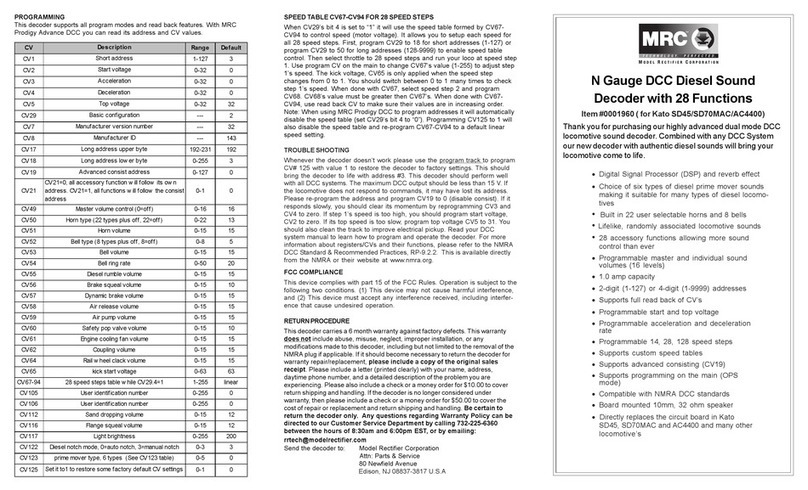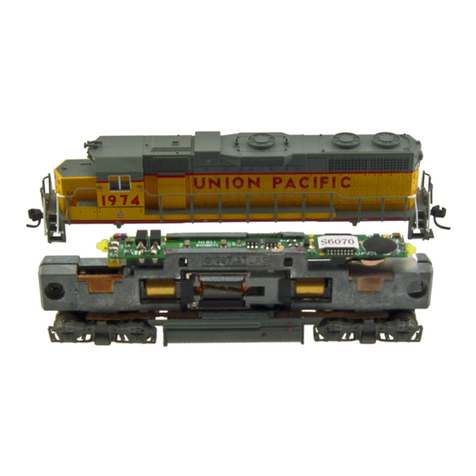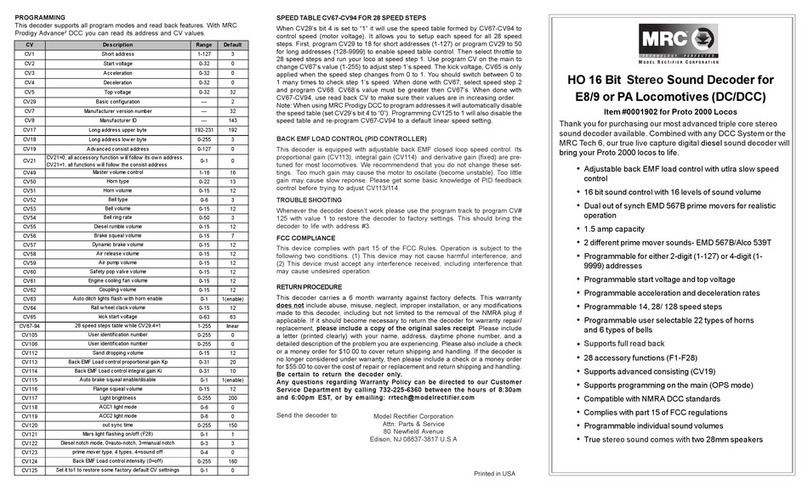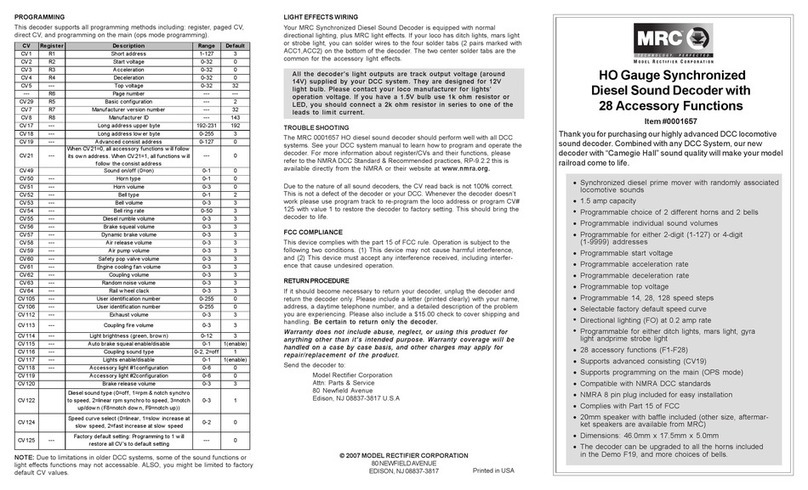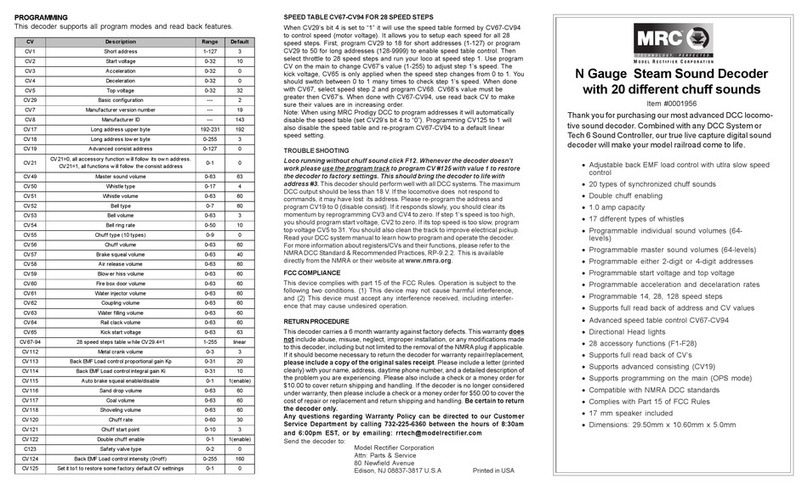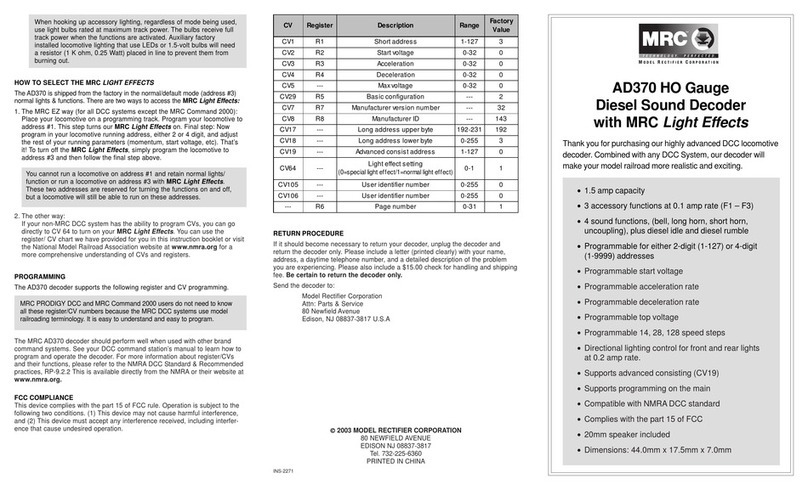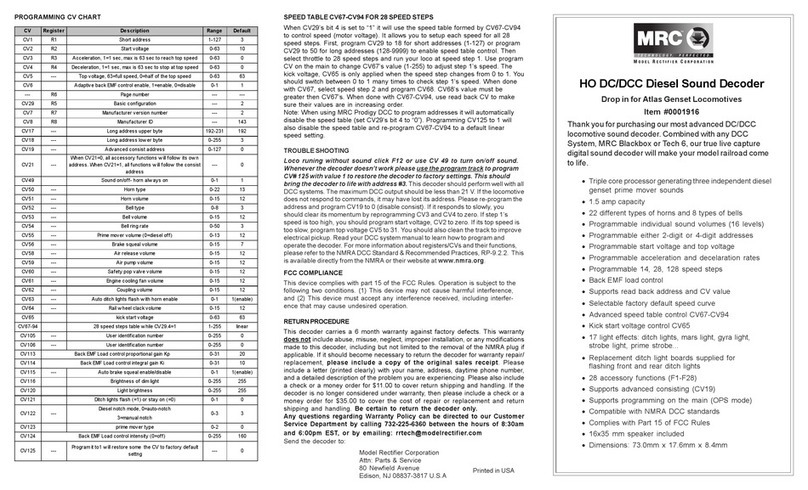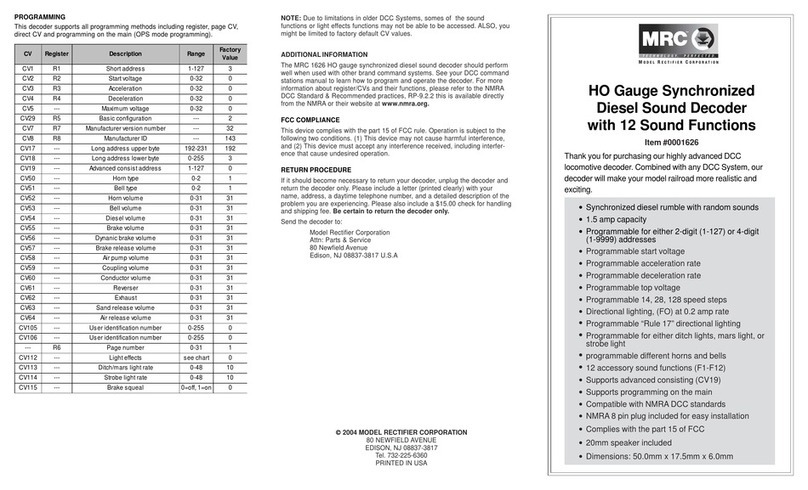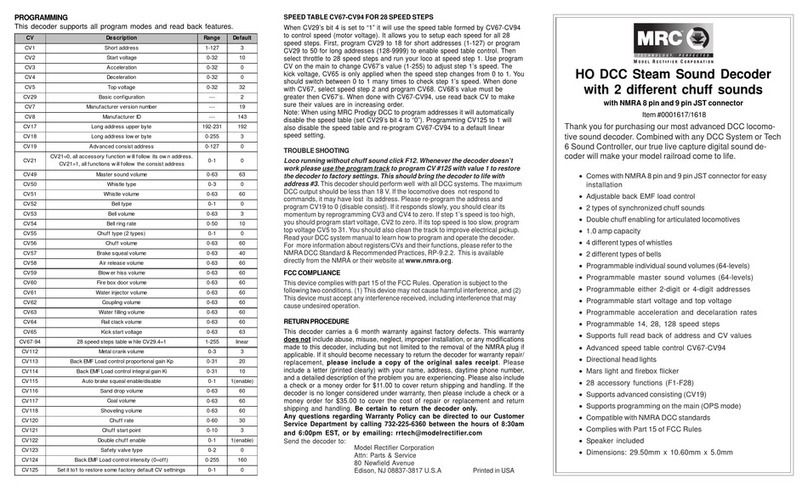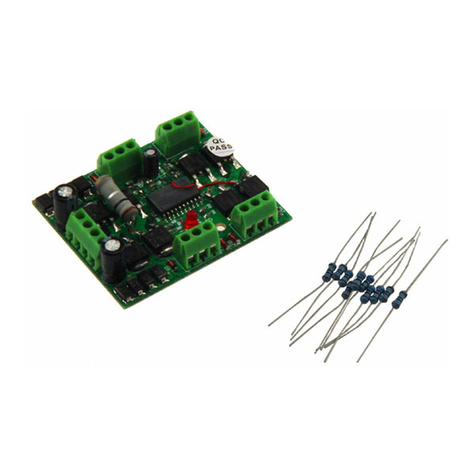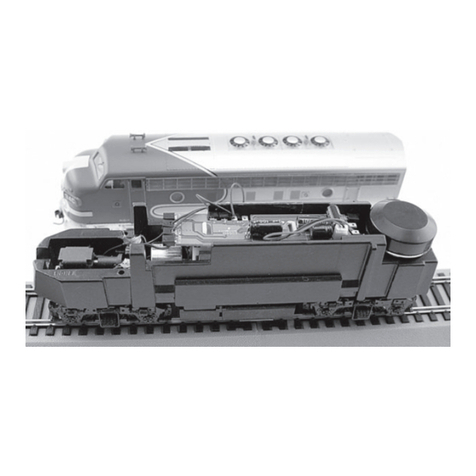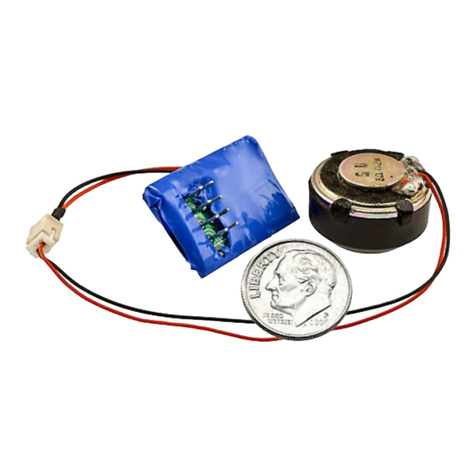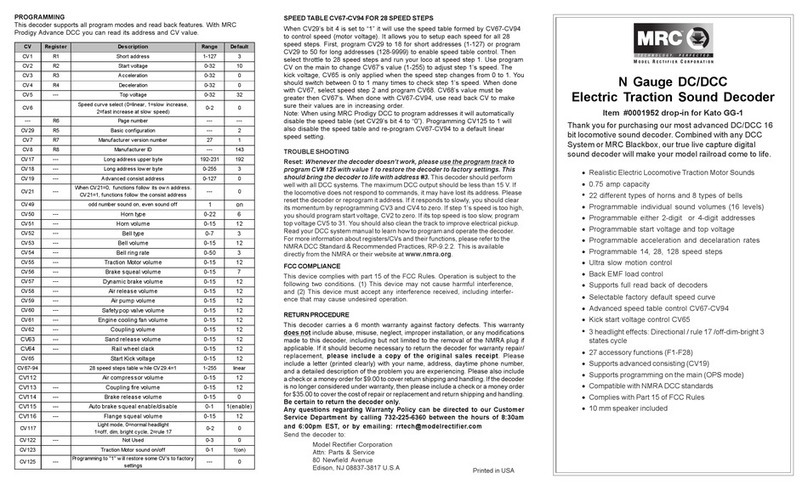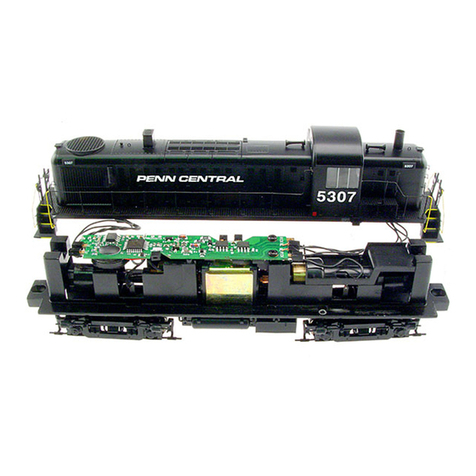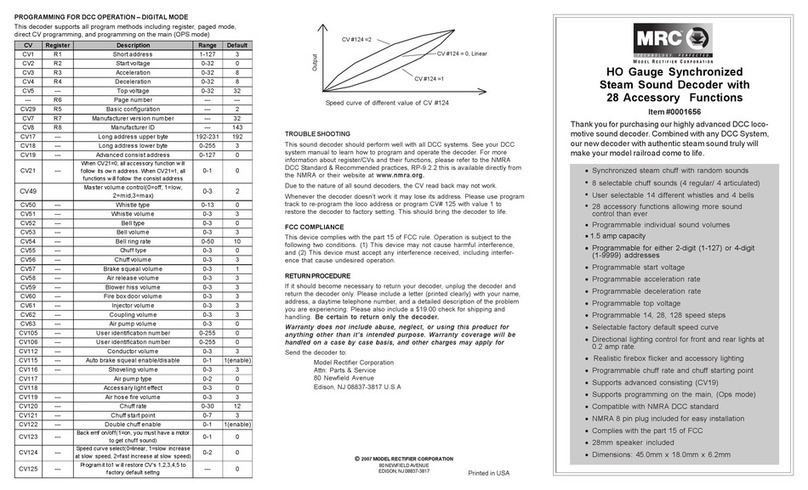
CV Register Description Range Default
CV1 R1 Short address 1-127 3
CV2 R2 Start voltage 0-32 0
CV3 R3 Acceleration 0-32 0
CV4 R4 Deceleration 0-32 0
CV5 --- Top voltage 0-32 32
CV6
Speed curve select (0=linear, 1=slow
increase at slow speed, 2=fast
increase at slow speed
0-2 0
--- R6 Page number --- ---
CV29 R5 Basic configuration --- 2
CV7 R7 Manufacturer version number --- 32
CV8 R8 Manufacturer ID --- 143
CV17 --- Long address upper byte 192-231 192
CV18 --- Long address lower byte 0-255 3
CV19 --- Advanced consist address 0-127 0
CV50 --- Horn type 0-16 4
CV51 --- Horn volume 0-3 3
CV52 --- Bell type 0-6 3
CV53 --- Bell volume 0-7 3
CV54 --- Bell ring rate 0-50 3
CV55 --- Diesel rumble volume 0-3 3
CV56 --- Brake squeal volume 0-3 3
CV57 --- Dynamic brake volume 0-3 3
CV58 --- Air release volume 0-3 3
CV59 --- Air pump volume 0-3 3
CV60 --- Safety pop valve volume 0-3 3
CV61 --- Engine cooling fan volume 0-3 3
CV62 --- Coupling volume 0-3 3
CV63 --- Random noise volume 0-3 3
CV64 --- Rail wheel clack 0-3 3
CV105 --- User identification number 0-255 0
CV106 --- User identification number 0-255 0
CV113 --- Coupling fire volume 0-3 3
CV114 --- brake release volume 0-3 3
CV115 --- Auto brake squeal enable/disable 0-1 1(enable)
CV116 --- Coupling sound type 0-2, 0=off 1
Diesel notch mode, 0=auto-notch
3=manual notch
CV125 --- Factory default setting, program it to1 w ill
restore all the CV to default settng --- 0
CV122 --- 0-3 0
0CV21 ---
When CV21=0, all accessory functions w ill
follow its ow n address. When CV21=1, all
functions w ill follow the consist address
---
TROUBLE SHOOTING
This decoder should perform well with all DCC systems. The maximum DCC
output should be less than 18 V. If the locomotive does not respond to
commands, it may have lost its address. Please re-program the address and
program CV19 to 0 (disable consist). If it responds to slowly, you should clear
its momentum by reprogramming CV3 and CV4 to zero. If step 1’s speed is too
high, you should program start voltage, CV2 to zero. If its top speed is too
slow, program top voltage CV5 to 31. You should also clean the track to
improve electrical pickup. Read your DCC system manual to learn how to
program and operate the decoder. For more information about registers/CVs
and their functions, please refer to the NMRA DCC Standard & Recommended
Practices, RP-9.2.2. This is available directly from the NMRA or their website
at www.nmra.org. Whenever the decoder doesn’t work please use the
program track to program CV# 125 with value 1 to restore the decoder to
factory settings. This should bring the decoder to life with address #3.
ADDITIONAL INFORMATION
The MRC 1663 HO gauge synchronized diesel sound decoder should perform
well when used with other brand command systems. See your DCC command
stations manual to learn how to program and operate the decoder. For more
information about register/CVs and their functions, please refer to the NMRA
DCC Standard & Recommended practices, RP-9.2.2 this is available directly
from the NMRA or their website at www.nmra.org.
FCC COMPLIANCE
This device complies with part 15 of the FCC Rules. Operation is subject to the
following two conditions. (1) This device may not cause harmful interference,
and (2) This device must accept any interference received, including interfer-
ence that may cause undesired operation.
RETURN PROCEDURE
If it should become necessary to return your decoder, remove the decoder
from the locomotive and return the decoder only. Please include a letter,
[printed clearly], with your name, address, daytime phone number, and a
detailed description of the problem you are experiencing. Please also include a
$20.00 check to cover shipping and handling. Be certain to return only the
decoder.
Warranty does not include abuse, neglect, or using this product for
anything other than it’s intended purpose. Warranty coverage will be
handled on a case by case basis, and other charges may apply for
repair/replacement of the product.
Send the decoder to:
Model Rectifier Corporation
Attn: Parts & Service
80 Newfield Avenue
Edison, NJ 08837-3817 U.S.A
2008 MODEL RECTIFIER CORPORATION
80 NEWFIELDAVENUE
EDISON, NJ 08837-3817 Printed in USA
HO DC/DCC Synchronized Diesel
Sound Decoder with 28 Accessory
Functions for Atlas S2/S4 Locomotive
Item #0001663
Thank you for purchasing our most advanced DC/DCC ALCo
sound decoder. Combined with any DCC System or MRC
Blackbox, our true live capture digital ALCo sound decoder will
bring your Atlas S2/S4 loco to life.
•Synchronized diesel prime mover with random
associated locomotive sounds
•1.5 amp capacity
•Programmable for either 2-digit (1-127) or 4-digit
(1-9999) addresses
•Programmable start voltage and top voltage
•Programmable acceleration and deceleration
rate
•Programmable 14, 28/ 128 speed steps
•Directional lighting, (FO). Sunny White
LED’s included
•Programmable user selectable horns and
bells
•Read back address and CV value
•28 accessory functions (F1-F28)
•Supports advanced consisting (CV19)
•Supports programming on the main (OPS
mode)
•Compatible with NMRA DCC standards
•Complies with part 15 of FCC regulations
•Programmable individual sound volumes
•18mm speaker included
PROGRAMMING
This decoder supports all program mode and read back feature. With MRC
Prodigy Advance DCC you can read its address and CV value.












